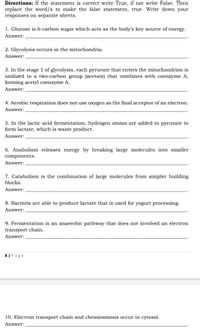
Human Anatomy & Physiology (11th Edition)
11th Edition
ISBN: 9780134580999
Author: Elaine N. Marieb, Katja N. Hoehn
Publisher: PEARSON
expand_more
expand_more
format_list_bulleted
Concept explainers
Topic Video
Question

Transcribed Image Text:Directions: If the statement is correct write True, if not write False. Then
replace the word/s to make the false statement, true. Write down your
responses on separate sheets.
1. Glucose is 6-carbon sugar which acts as the body's key source of energy.
Answer:
2. Glycolysis occurs in the mitochondria.
Answer:
3. In the stage 1 of glycolysis, each pyruvate that enters the mitochondrion is
oxidized to a two-carbon group (acetate) that combines with coenzyme A,
forming acetyl coenzyme A.
Answer:
4. Aerobic respiration does not use oxygen as the final acceptor of an electron.
Answer:
5. In the lactic acid fermentation, hydrogen atoms are added to pyruvate to
form lactate, which is waste product.
Answer:
6. Anabolism releases energy by breaking large molecules into smaller
components.
Answer:
7. Catabolism is the combination of large molecules from simpler building
blocks.
Answer:
8. Bacteria are able to produce lactate that is used for yogurt processing.
Answer:
9. Fermentation is an anaerobic pathway that does not involved an electron
transport chain.
Answer:
8 | Page
10. Electron transport chain and chemiosmosis occur in cytosol.
Answer:
Expert Solution
This question has been solved!
Explore an expertly crafted, step-by-step solution for a thorough understanding of key concepts.
Step by stepSolved in 3 steps

Knowledge Booster
Learn more about
Need a deep-dive on the concept behind this application? Look no further. Learn more about this topic, biology and related others by exploring similar questions and additional content below.Similar questions
- Please make a health exercise goal and complete each question 1- 10 Verify that your goal is SMART 1. Specific: What exactly will you accomplish? ________________________________________________________________________________ ________________________________________________________________________________ ________________________________________________________________________________ 2.Measurable: How will you know when you have reached this goal? ________________________________________________________________________________ ________________________________________________________________________________ 3. Achievable: Is achieving this goal realistic with effort and commitment? Have you got the resources to achieve this goal? If not, how will you get them? ________________________________________________________________________________ ________________________________________________________________________________…arrow_forwardHealth Science Question: Answer in 15 minutes no more than that- Answer correctly and read the question correctly, I do not need an explanation to why these are the correct answer, I just would like the key answer please and thank you. If the question is done correctly, I will write a very wonderful and long review about you!arrow_forwardplease please answer everything in the image attached i would really appreciate itarrow_forward
arrow_back_ios
arrow_forward_ios
Recommended textbooks for you
 Human Anatomy & Physiology (11th Edition)BiologyISBN:9780134580999Author:Elaine N. Marieb, Katja N. HoehnPublisher:PEARSON
Human Anatomy & Physiology (11th Edition)BiologyISBN:9780134580999Author:Elaine N. Marieb, Katja N. HoehnPublisher:PEARSON Biology 2eBiologyISBN:9781947172517Author:Matthew Douglas, Jung Choi, Mary Ann ClarkPublisher:OpenStax
Biology 2eBiologyISBN:9781947172517Author:Matthew Douglas, Jung Choi, Mary Ann ClarkPublisher:OpenStax Anatomy & PhysiologyBiologyISBN:9781259398629Author:McKinley, Michael P., O'loughlin, Valerie Dean, Bidle, Theresa StouterPublisher:Mcgraw Hill Education,
Anatomy & PhysiologyBiologyISBN:9781259398629Author:McKinley, Michael P., O'loughlin, Valerie Dean, Bidle, Theresa StouterPublisher:Mcgraw Hill Education, Molecular Biology of the Cell (Sixth Edition)BiologyISBN:9780815344322Author:Bruce Alberts, Alexander D. Johnson, Julian Lewis, David Morgan, Martin Raff, Keith Roberts, Peter WalterPublisher:W. W. Norton & Company
Molecular Biology of the Cell (Sixth Edition)BiologyISBN:9780815344322Author:Bruce Alberts, Alexander D. Johnson, Julian Lewis, David Morgan, Martin Raff, Keith Roberts, Peter WalterPublisher:W. W. Norton & Company Laboratory Manual For Human Anatomy & PhysiologyBiologyISBN:9781260159363Author:Martin, Terry R., Prentice-craver, CynthiaPublisher:McGraw-Hill Publishing Co.
Laboratory Manual For Human Anatomy & PhysiologyBiologyISBN:9781260159363Author:Martin, Terry R., Prentice-craver, CynthiaPublisher:McGraw-Hill Publishing Co. Inquiry Into Life (16th Edition)BiologyISBN:9781260231700Author:Sylvia S. Mader, Michael WindelspechtPublisher:McGraw Hill Education
Inquiry Into Life (16th Edition)BiologyISBN:9781260231700Author:Sylvia S. Mader, Michael WindelspechtPublisher:McGraw Hill Education

Human Anatomy & Physiology (11th Edition)
Biology
ISBN:9780134580999
Author:Elaine N. Marieb, Katja N. Hoehn
Publisher:PEARSON

Biology 2e
Biology
ISBN:9781947172517
Author:Matthew Douglas, Jung Choi, Mary Ann Clark
Publisher:OpenStax

Anatomy & Physiology
Biology
ISBN:9781259398629
Author:McKinley, Michael P., O'loughlin, Valerie Dean, Bidle, Theresa Stouter
Publisher:Mcgraw Hill Education,

Molecular Biology of the Cell (Sixth Edition)
Biology
ISBN:9780815344322
Author:Bruce Alberts, Alexander D. Johnson, Julian Lewis, David Morgan, Martin Raff, Keith Roberts, Peter Walter
Publisher:W. W. Norton & Company

Laboratory Manual For Human Anatomy & Physiology
Biology
ISBN:9781260159363
Author:Martin, Terry R., Prentice-craver, Cynthia
Publisher:McGraw-Hill Publishing Co.

Inquiry Into Life (16th Edition)
Biology
ISBN:9781260231700
Author:Sylvia S. Mader, Michael Windelspecht
Publisher:McGraw Hill Education